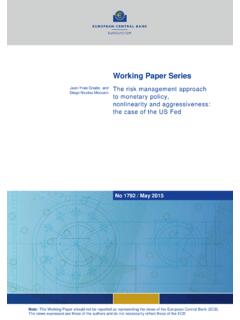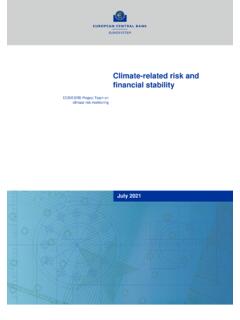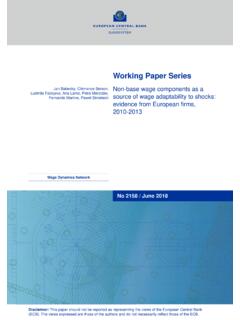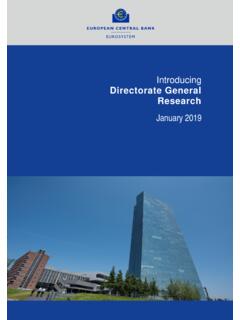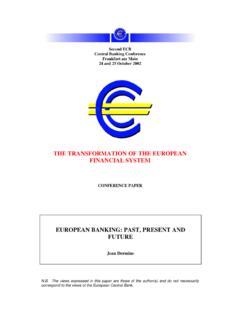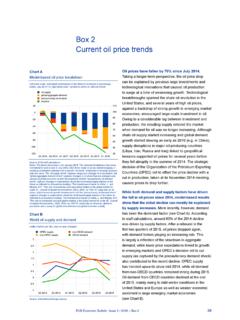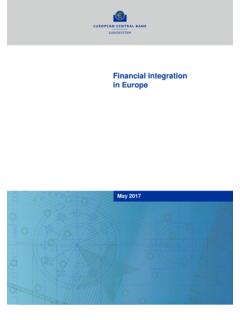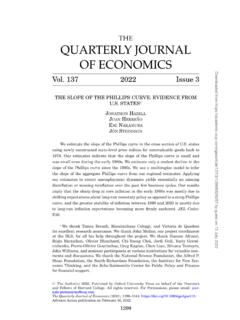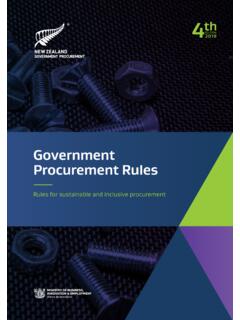Transcription of The supply of money - bank behaviour and the implications ...
1 63 ECBM onthly BulletinOctober 20111 introduction The role of monetary analysis in the ECB s monetary policy strategy is founded on the robust positive relationship between longer-term movements in broad money growth and inflation, whereby money growth leads inflationary developments. This relationship is found to hold true across countries and monetary policy Accordingly, when trying to identify the contributions to monetary growth that are associated with risks to price stability, it is necessary to look for changes of a persistent nature or that are driven by factors beyond the normal needs of the economic cycle. In this respect, the supply of money and credit may be affected by persistent advances in banks intermediation capacity, thus contributing to longer-term price developments in asset and goods markets, and in the short-term by market perception of the financial soundness of banks.
2 Thus, from a monetary analysis perspective, understanding developments in banks behaviour is an important element in deriving the signals for risks to price stability. Section 2 of the article develops a framework for understanding why advancements in the bank intermediation process may have led to persistent developments in money and credit growth, ultimately affecting macroeconomic developments relevant for monetary policy . Section 3 discusses selected examples, which illustrate how banking operations in the euro area have undergone significant changes in the past decade. On the liability side of the balance sheet, the internationalisation of interbank funding is a significant development while, on the asset side, the growing use of loan sales and securitisation activity stands out. Section 4 concludes.
3 2 What role For banK behaviour in monetary analysis? Bank behaviour is one important determinant of money and credit developments, both of a cyclical and of a more persistent nature. Neglecting this role is akin to assigning financial intermediaries only a passive role in the economy. In recent years, against the background of the financial crisis, it has become increasingly evident that such a passive view of banks is unwarranted. money demand Versus money supplyThe volume of broad money in the economy is the result of the interaction of the banking sector (including the central bank) with the money -holding sector, consisting of households, non-financial corporations, the general government other than central government, as well as non- monetary financial intermediaries. Broad money comprises currency in circulation and See Papademos, L.
4 And Stark, J. (eds.), 1 Enhancing monetary Analysis, ECB Frankfurt am Main, 2010, Chapter 1 and the references cited ECB s monetary policy strategy assigns a prominent role to monetary analysis as one element of the two-pillar framework for the assessment of risks to price stability in the euro area. monetary analysis ensures that the important information stemming from money and credit is considered in the monetary policy decision-making process and provides a cross-check from a medium to long-term perspective of the assessment of risks to price stability based on the economic analysis. Through an analysis of money and credit developments, this article looks at the impact of banks intermediation activity on the macroeconomy with respect to both conjunctural developments and the assessment of nominal trends. Persistent changes in banks behaviour are likely to affect the economy in an enduring and significant manner.
5 The analysis of money and credit growth is thus crucial for conducting an appropriate monetary supply oF money banK behaviour and the implications For monetary analysis64 ECBM onthly BulletinOctober 2011close substitutes, such as bank deposits, and is informative for aggregate spending and infl ation. It thus goes beyond those assets that are generally accepted means of payment to include instruments that function mainly as a store of value. Empirical models for money holdings are applied for two purposes. First, they are used to guide the analysis of monetary developments, as a means of quantifying the contribution of various economic determinants to money growth in order to provide a deeper understanding of the causes of money growth. This is necessary in order to develop a view of underlying monetary expansion. Second, the models provide a normative framework to assess whether the stock of money in the economy is consistent with price stability and to interpret the nature of deviations from this norm.
6 An understanding of why the money stock deviates from an equilibrium level, defi ned on the basis of empirical regularities, is therefore essential from a monetary policy Identifying whether monetary developments are driven by money demand or money supply is of prime relevance when assessing the relationship between money , asset price developments and wealth. Indeed, the holdings of broad money , as one element in the portfolio of economic agents, are determined by the size of agents wealth. At the same time, asset prices, and thus the overall wealth position of agents, may be infl uenced by money supply . The assessment of monetary developments is therefore closely linked to an assessment of the sustainability of wealth and asset price the observed level of money is assessed as being consistent with the level of prices, income and interest rates, then money growth refl ects the economic situation.
7 Risks to price stability resulting, for example, from strong economic growth would be visible in If, however, observed monetary developments do not evolve in line with expectations based on the historical relationship with prices, income and interest rates, then the appropriate monetary policy response will depend on the underlying forces leading to this deviation. If the inconsistency is the result of demand considerations, resulting, for instance, from heightened fi nancial uncertainty, monetary policy should not necessarily react to monetary developments. For example, the increase in M3 holdings in the period from 2001 to mid-2003 that was identifi ed as resulting from a shift in preference towards holding safe and liquid assets owing to heightened uncertainty was not linked to the emergence of risks to price stability (see Chart 1, which shows the difference between the broad monetary aggregate M3 and M3 corrected for the estimated impact of See Papademos, L.)
8 And Stark, J. (eds.), 2 Enhancing monetary Analysis, ECB Frankfurt am Main, 2010, Chapter the article entitled Asset price bubbles and monetary policy 3 revisited , Monthly Bulletin, ECB, November , even in this case, money can play an important 4 informative role owing to errors or revisions in the measurement of other macroeconomic variables such as output. See Coenen, G., Levin, A. and Wieland, V., Data uncertainty and the role of money as an information variable for monetary policy , European Economic Review, Vol. 49, No 4, May 2005, pp. 1 broad money and loan growth(annual percentage changes; adjusted for seasonal and calendar effects)-202468101214-202468101214199920 0120032005200720092011 MFI loans to the private sectorM3 corrected for the estimated impact of portfolio shifts 1)M3 Source: ) Estimates of the magnitude of portfolio shifts into M3 are constructed using the approach discussed in Section 4 of the article entitled monetary analysis in real time in the October 2004 issue of the Monthly BulletinOctober 2011articlesThe supply of money bank behaviour and the implications for monetary analysisportfolio shifts).
9 By contrast, if monetary developments deviate from the economic determinants as a result of a shift in money supply that is caused either by a structural change or a shift in the perception of risks, this would call for an adjustment of monetary policy to the extent that the deviation is likely to affect inflation. Explanations relating to money supply are often linked to the intermediation and the money creation processes, and highlight the interdependence between the credit and the money principle, it is possible to distinguish between money supply and money demand at a conceptual level in a static setting. however, in a dynamic context, it is difficult to assess which of these forces is mainly driving actual developments, as the determinants of money growth often affect both sides, and demand and supply money supply and monetary policy money supply originates in the behaviour of the central bank and banks.
10 A common distinction made in this respect is the supply of outside money provided by the central bank consisting of banknotes and banks reserves with the central bank and inside money created by banks, consisting mainly of deposits. Pedagogical accounts of how monetary policy exerts an influence on the supply of broad or inside money in the economy traditionally rely on the money multiplier approach. According to this approach, the money supply process is essentially driven by the actions of the central bank, which conducts monetary policy by adjusting the level of outside money . The volume of broad money supplied to the economy is then simply determined as a multiple of the monetary base, depending on the size of the money multiplier. The concept of the money multiplier derives from the basic feature of deposit banking that, under normal conditions and when there is confidence in the banking system, banks only need to maintain a fraction of the deposits they have accepted in the form of highly liquid, cash-equivalent assets (such as central bank reserves).
